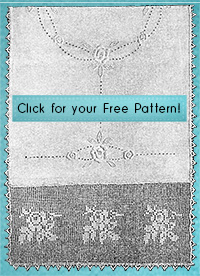How to Choose the Best Crochet Thread
The colors, the quality, and the resulting fabric of your masterpiece are the choices you’ll have to make before you start your lace project. Today, there are numerous types of crochet thread. The permutations are endless, and each type brings new and interesting variations.
If you’re only used to using regular yarn to crochet with, you might need some help deciding which thread to use. The selection at your local craft store is very limited, and it’s hard to tell from the appearance or texture of the thread that’s available what your final result will be. Manufacturers don’t clearly state the content or gauge on thread, unlike yarn labels that are usually so helpful.
I know it’s very difficult to wait when you want to start a project, but if your local craft or yarn store doesn’t carry anything but bargain brands, go online to find the right thread for your lace.
Here are some tips for choosing the best kind of crochet thread for your project:
1. Decide on the content of the thread
The most frequently used crochet thread is 100% cotton. It’s very durable and can last decades, it’s easy to wash, and it’s easy to work with.
Crochet thread is also available in bamboo, nylon, and cotton blends. These are nice for making garments.
Thread with an added metallic ply is great for snowflakes. Some thread has luster and is fun for purses, hats and belts.
2. Decide on the type of crochet thread
Crochet thread is very tightly wound (hmmm…) and resistant to snags and splitting while you’re working with it. Most cotton thread is mercerised, a process that pre-shrinks and strengthens the fibers, and gives the thread a lustre. If the label on the thread doesn’t say that it’s mercerised, don’t buy it.
Perle cotton isn’t good for home décor items, but with its lovely sheen, it’s great for soft lace edgings to match a garment.
3. Decide on the size of thread
Crochet cotton starts at size 5 and continues down to size 80. Choose the size thread based on how large or small you want your finished lace to be, and whether you want the finished lace to be coarse or delicate.
Size 5 is the biggest thread, and I don’t really recommend it for general use unless you’re making something very large like a bedspread or curtains. The lace that results is kind of stiff and coarse, so if you’re making a garment or shawl it would be better to use fingering weight yarn instead. If you want to buy size 5 just because it’s easier to see, get some magnifying glasses. If you’re a beginner at lace and want a large thread to try it out with, then use some worsted weight yarn that you have around the house for a small piece.
People use size 10 crochet cotton for almost everything. It’s the size that’s usually stocked in stores, and comes in lots of colors. I like to mess around with the smaller sizes, and usually use size 20 thread for doilies because the results are a little more dainty. The next smaller sizes are 30, 50 and 80 (also called tatting thread).
4. Decide on the brand of the thread
When you’re making lace that you want to last for years and years; if you don’t want your hook to snag on the thread while you’re working; if you want a fine sheen and finish to the fabric that you’re making, then there is only one rule: Do not buy any crochet cotton with “thrifty”, “bargain”, or “heart” on the label, or anything else without “DMC” on the label. Again, if your local store doesn’t carry what you want, either request it or go online to buy it. Be patient. Let’s face it, you’d have more fun standing on the corner throwing dollar bills into the street than crocheting with inferior thread.
5. Buy more than you need It’s always best to have an extra ball of thread. It’s painful to run out of thread when you only have a few more rows to go. Even though crochet cotton doesn’t usually come in dye lots, the next ball you buy from a different source might not quite match, plus you’ll probably have to wait for it.
Here’s DMC’s crochet section on their website: http://dmc-usa.com/Products/Needlework-Threads/Crochet-Threads.aspx.











